Product Images Gabapentin
View Photos of Packaging, Labels & Appearance
- image description - Figure
- image description - Formula
- image description - Graph
- image description - Graph2
- image description - Label
- image description - Module
- image description - Table1 1
- image description - Table1
- image description - Table2 1
- image description - Table2
- image description - Table3 2
- image description - Table3
- image description - Table4 1
- image description - Table4
- image description - Table5
- image description - Table6
Product Label Images
The following 16 images provide visual information about the product associated with Gabapentin NDC 61919-102 by Direct Rx, such as packaging, labeling, and the appearance of the drug itself. This resource could be helpful for medical professionals, pharmacists, and patients seeking to verify medication information and ensure they have the correct product.
image description - Graph
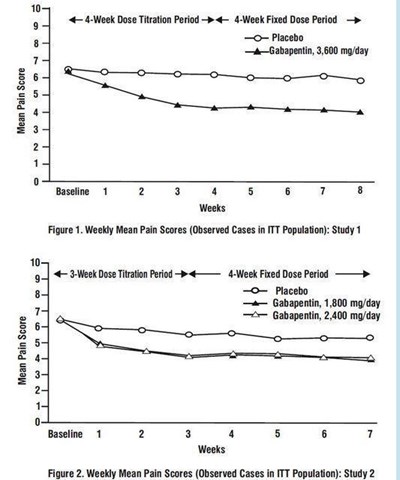
The texts describe two different studies evaluating the effect of gabapentin on pain reduction using a mean pain score measure. The first study consisted of an 8-week dose titration period followed by a 4-week fixed dose period, with either placebo or 3,600 mg/day of gabapentin, while the second study consisted of a 3-week dose titration period followed by a 4-week fixed dose period with either placebo, 1,800 mg/day or 2,400 mg/day of gabapentin. Weekly mean pain scores were observed in the ITT population for each study.*
image description - Label
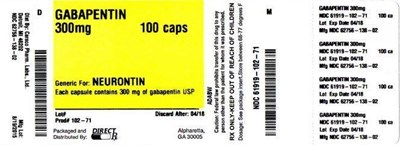
This text appears to be a list of medications containing Gabapentin, a medication used to treat seizures and nerve pain. The list includes the medication name, dosage, expiration date, and package details. The text also includes a warning to keep the medication out of reach of children and a note that it is only available with a prescription (Rx only).*
image description - Table1 1

The text provides a medication dosage information with the frequency and strength of the dose. The medication can be taken 1,200 times a day (TID), 700 times a day (BID), 700 times a day (QD), and 300 times a day (QD). The strength of the medication is 350 mg per dose.*
image description - Table1
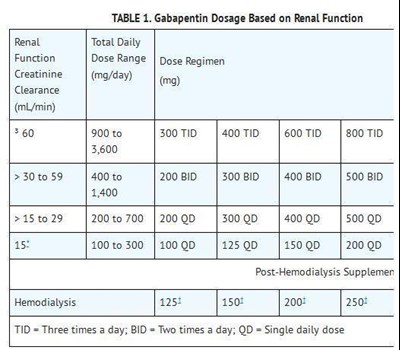
The given text describes a table indicating the dosage of Gabapentin medicine that should be prescribed based on the renal function of the patient. The dosage, measured in mg/day and g, as well as the dosage regimen, such as TID (thrice daily), BID (twice daily), or QD (single daily dose) is given for different ranges of creatinine clearance (measured in mL/min). Additionally, post-hemodialysis supplement dose of the medicine is also given for hemodialysis patients.*
image description - Table2 1
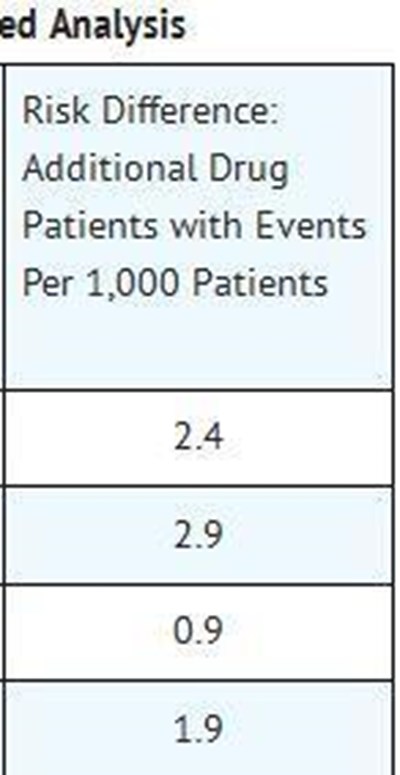
This appears to be a partial section header from a document discussing risk analysis, specifically focusing on drug-related events in patients. It provides information on measuring the risk difference between groups of patients taking different drugs, potentially in terms of the number of additional drug-related events observed per 1,000 patients. Without further context or information, it is difficult to provide a more specific description.*
image description - Table2
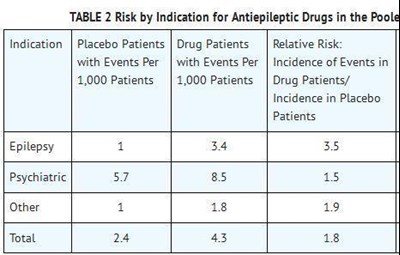
This is a table showing the relative risk associated with antiepileptic drugs in different indications, including epilepsy, psychiatric disorders, and other conditions. The table presents data on the number of patients with events per 1,000 patients for both placebo and drug treatments, as well as the incidence of events in drug patients relative to incidence in placebo patients.*
image description - Table3 2
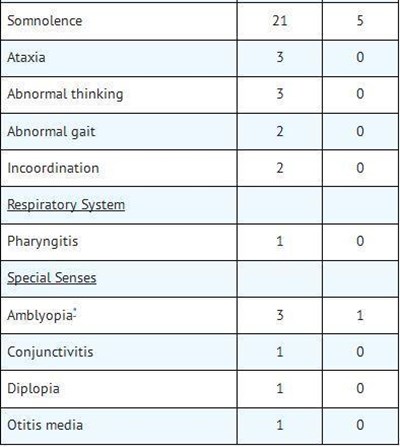
This text appears to be a list of medical symptoms and conditions, including somnolence, ataxia, abnormal thinking, abnormal gait, incoordination, pharyngitis, amblyopia, conjunctivitis, diplopia, and otitis media. The numbers next to each symptom may indicate the severity or frequency of the symptom.*
image description - Table3
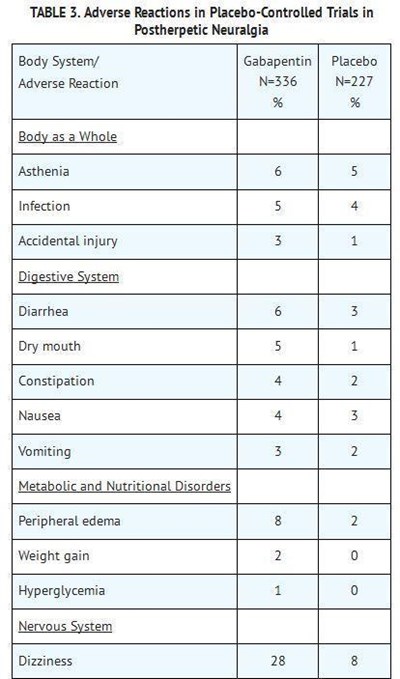
This table shows the adverse reactions reported in placebo-controlled trials for Gabapentin used in treating Postherpetic Neuralgia. Adverse reactions reported for the body system, gastrointestinal system, and nervous system are listed. The number of patients that experienced the reaction out of the total number of patients in the study is also included as a percentage for both Gabapentin and placebo.*
image description - Table4 1
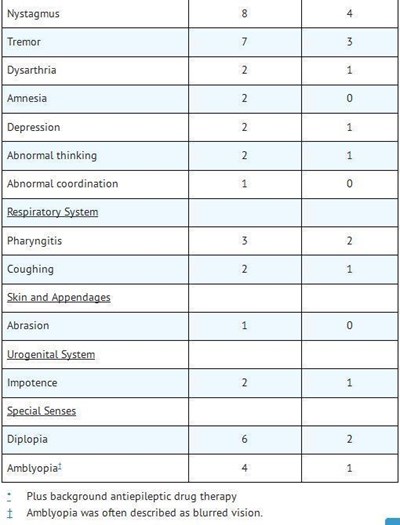
This is a chart showing the frequency and severity of various medical symptoms in a group of patients. The symptoms are categorized by body system, including the nervous system (with symptoms such as nystagmus and tremors), respiratory system (with symptoms such as pharyngitis and coughing), skin and appendages (with a symptom of abrasion), urogenital system (with a symptom of impotence), and special senses (with symptoms of diplopia and amblyopia). The patients in the study also had background antiepileptic drug therapy. Amblyopia is noted as a symptom of blurred vision.*
image description - Table4
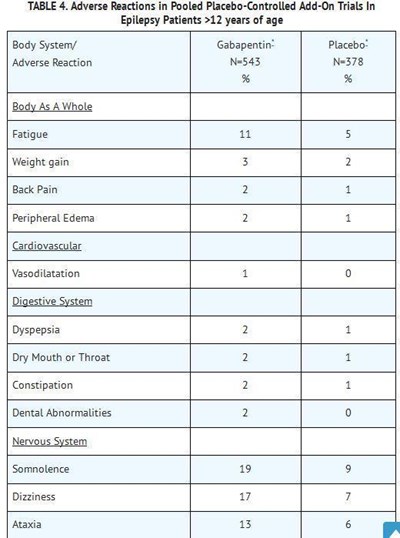
This is a table presenting the adverse reactions observed in epilepsy patients above 12 years of age in pooled placebo-controlled add-on trials while taking Gabapentin compared to placebo. The table lists various body systems and the corresponding reactions along with the percentage of patients experiencing them. The adverse reactions observed include fatigue, weight gain, back pain, peripheral edema, vasodilatation, dyspepsia, dry mouth or throat, constipation, dental abnormalities, somnolence, dizziness, and ataxia.*
image description - Table5
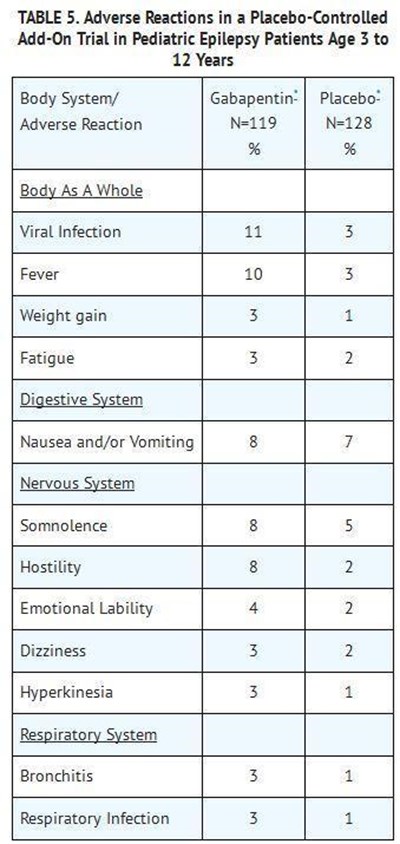
This is a table with adverse reactions in a placebo-controlled add-on trial for pediatric epilepsy patients ages 3 to 12 who were given Gabapentin. The adverse reactions are categorized by body system and there is a comparison with the placebo group. Adverse reactions for the Gabapentin group were: viral infection, fever, weight gain, fatigue, nausea and/or vomiting, somnolence, hostility, emotional lability, dizziness, hyperkinesia, bronchitis, and respiratory infection. The table indicates the percentage of occurrence for each adverse reaction.*
image description - Table6
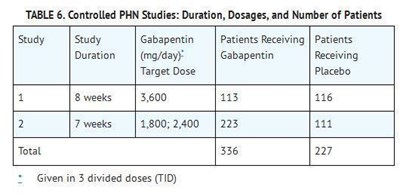
This table presents information on controlled PHN (postherpetic neuralgia) studies, including the duration of the studies, dosages of Gabapentin administered to the patients, and the number of patients receiving Gabapentin and placebo. The Gabapentin was administered three times a day (TID) in either 3600 mg/day or divided doses of 1800 and 2400 mg/day. In the 8-week study, 113 patients received Gabapentin and 116 received placebo. In the 27-week study, 223 patients received Gabapentin, and only 11 received placebo.*
* The product label images have been analyzed using a combination of traditional computing and machine learning techniques. It should be noted that the descriptions provided may not be entirely accurate as they are experimental in nature. Use the information in this page at your own discretion and risk.


